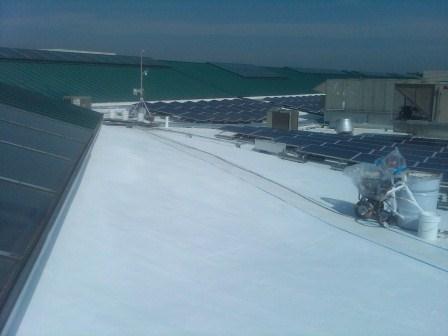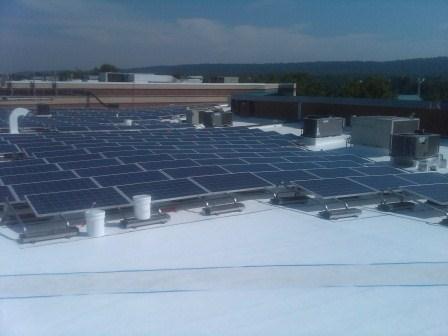Bridgewater Commons is a large shopping mall in Bridgewater, N.J., that recently was in need of a roof renovation. Together, Tecta America and Quest Construction Products came up with a coating system solution that gave this shoppers’ paradise a durable, energy efficient, and cost-effective roof rehabilitation.
Shopping for a Solution
When Tecta America arrived on the scene, the first order of business was to determine the right course of action for the project. Depending on the condition of the substrate, there would be several different options, including a complete removal of the existing roof or the less extreme (and less costly) option of adding a protective coating system to the current roof. “The substrate is a modified bitumen roof over a metal deck. The roof was in fair condition. Many times, it is simply too late to do anything but a complete tear-down and rebuild of the roof, but that was not the case with this project,” said Michele Fischman of Tecta America. An infrared scan was conducted on the roof and no wet or deteriorated insulation was found, making the 160,000-square-foot (14,864 m²) job the perfect candidate for a protective coating system.
In addition, the roof of Bridgewater Commons has good pitch, meaning that drainage was not and would not become a problem in the future.“The pitch of the roof was such that ponding wouldn’t be an issue. Ponding can cause coatings to deteriorate over time and lead to coatings failure,” explained Fischman.
With the discovery that a coating system would be the right fit for this retail center, the Tecta America crew teamed up with Quest Construction Products. It was decided to apply the Quest Roofmate system on the roof. This system consists of a primer, basecoat, embedded reinforcement fabric around all penetrations, and topcoat. “The Quest Roofmate system was a great choice for the roof of the mall. It is a 48-mil [1,219 microns] dry film thickness, monolithic, weather-tight  roofing coating system,” said Ron Head of Quest Construction Products. Quest Roofmate is also a white coating with reflective properties. It is Energy Star approved and is sustainable. In other words, it is environmentally friendly and will aid in reducing energy usage and costs.
roofing coating system,” said Ron Head of Quest Construction Products. Quest Roofmate is also a white coating with reflective properties. It is Energy Star approved and is sustainable. In other words, it is environmentally friendly and will aid in reducing energy usage and costs.
Barrels and Barrels of Coating
With a project of this size, the 5-man Tecta crew knew that a lot of coating material would be needed onsite. The team ordered 200 55-gallon (208 L) barrels, and they were ready to begin work. However, Mother Nature had different ideas.
The job was awarded in November and cold, wet winter weather was rapidly approaching the state of New Jersey. It was decided that the best course of action would be to wait until the warmer, drier weather of springtime. As with many coatings products, the Quest Roofmate materials are sensitive to extremely cold temperatures and could not be stored outside. “At that point, we realized that there was no inside area onsite to store the material. Luckily, we had space in our warehouse to store the 200 barrels of coating,” revealed Fischman. Although the warehouse is not temperature controlled, the area remained warm enough to ensure that the coating barrels would not be compromised by the cold New Jersey winter.
The Tecta America crew waited out the winter season, and, in April 2012, they were ready to begin installing the coating system. The barrels were brought to the shopping center site and a crane was used to load the barrels onto the roof in two stages. However, the sheer volume of the barrels of coating presented yet another challenge. “Because the roof has a metal deck, we had to be very careful not to place too many barrels in one area or the weight of the barrels would destroy the roof structure. Throughout the project, it was like placing pieces on a giant chessboard — the crew was constantly moving the barrels depending on where we were applying the coating and strategically distributing the weight of the barrels,” said Fischman.
Sealing the Deal
 In addition to the barrel moving strategy, the crew also had to contend with ensuring that the existing roof deck was properly prepared for the coating application. The entire roof was power-washed to remove all dirt and debris. “We had to pay special attention to the food court area, as it had a lot of grease and oil build-up,” stated Fischman. A cleaning agent was used along with the power-washing to ensure that all the grease and oil were removed and that the roof was ready to accept the Quest Unibase primer.
In addition to the barrel moving strategy, the crew also had to contend with ensuring that the existing roof deck was properly prepared for the coating application. The entire roof was power-washed to remove all dirt and debris. “We had to pay special attention to the food court area, as it had a lot of grease and oil build-up,” stated Fischman. A cleaning agent was used along with the power-washing to ensure that all the grease and oil were removed and that the roof was ready to accept the Quest Unibase primer.
Once the power-washing process was completed, the crew applied the Quest Unibase primer at the rate of 1 gallon per 150 square feet (4 L/14 m²) using Graco 7900 spray equipment. In fact, two Graco 7900s were used for each phase of the coating application. With the primer laid down, the crew then applied two coats of Quest Roofmate basecoat at a rate of 1.5 gallons per 100 square feet (6 L/9 m²) per pass. All areas with penetrations and areas that were to receive solar panels had Quest Roofmate fabric embedded in between the first and second coats of the basecoat. Two coats of Quest Roofmate topcoat were then applied to the roof at a rate of 1.6 gallons per 100 square feet (6 L/9 m²) per pass.
According to Head, the cure time for each of the coating system components varies depending on the weather — hotter, drier weather equals a quicker cure time. To ensure that the coating had properly cured, the Tecta America crew waited 24 hours in between the application of each layer of the coating system. “We usually applied the coating during the hours of 10 a.m. and 2 p.m., which is the warmest part of the day,” said Fischman.
Both Fischman and Head are quick to point out that safety was a top priority on the job. “The walls on the roof are high enough that the risk of overspray was almost nil, and fall protection wasn’t necessary for the crewmembers,” stated Fischman. The crew wore face masks and all other required safety equipment throughout the duration of the five month project.
One Stop Shop
Although the Tecta America crew faced some challenges, the Bridgewater Commons roof project was a success due to the expertise of the crew and the selection of a durable and cost effective protective coating system. “Coatings aren’t right for every roof rehabilitation job, especially those that have water damage or compromised insulation,” said Fischman. “However, when the existing roof is in good condition, the application of a high-quality coating system [like Quest Roofmate] is a great solution.”